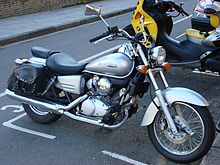Honda Shadow
As of 2011, the Shadow brand has been limited to a single 750 cc cruiser available in Spirit, Aero, Phantom, and RS trims.
The engine was the Honda VT500, a 491 cc (30.0 cu in) OHC three-valve, liquid cooled V-Twin that averaged around 51.7MPG[11] and put out 54HP@9,000RPM and 31 ft-Ib of torque @7,000RPM and mated to a six-speed, shaft drive transmission.
The engine is a 583 cc (35.6 cu in) SOHC three-valve liquid cooled 52-degree V-Twin that averaged 49.5MPG [12] and unlike prior models this engine utilized a shared crankpin to have a more Harley Davidson-like sound & shake thus generating a low 39HP[13] @6,500rpm and 36 ft-Ib of torque @3,500RPM connected to a four-speed transmission and chain drive.
In 1999 the dual Keihin CV carburetors were replaced by a single vertical Keihin CV carburetor more like the single carbs found on Harley Davidsons via different heads and a special intake manifold again like many Harley Davidsons, this further reduced horsepower from 39 hp down to 35 hp.
A 1983 model year 750cc V-twin motorcycle is the senior member in the large family of Honda cruisers (of various sizes) named Shadow.
[14] Even after multiple engine redesigns the current Shadow 750 still uses the same general layout as the 1983 motor: 4-stroke liquid-cooled narrow-angle V-twin, SOHC three-valve cylinder heads with dual spark plugs.
Both were propelled by a new 750 cc liquid-cooled four-stroke dual-carburetor SOHC three-valve 45-degree V-twin engine with a six-speed transmission and shaft final drive.
[7][9] In a January 1983 road test, Cycle said: "This 750 twin is built around what is arguably the most technologically sophisticated Vee ever designed.
[16][17] In addition to the V-engine, the Shadow's frame and body incorporated classic American cruiser styling cues: a teardrop fuel tank (with a hidden sub-tank to increase capacity), a low height two-piece seat with sissy bar and backrest, cruiser handlebar, cast wheels, chrome front fender, a round head lamp and instrument casings, large rake angle and angle-cut mufflers.
[15] For the 1986 model year, Japan's NV750C was renamed Honda Shadow as part of appearance and frame updates, including a lower seat, longer wheelbase, increased rake and trail as well as a rod linkage for the rear brake (previously cable operated).
"[24] Honda introduced the Shadow 700cc model in 1984 exclusively for the US market in response to tariffs (to protect Harley-Davidson) on Japanese motorcycles with engines over 700cc.
Honda took the RC14E 45-degree V-twin and reduced its bore size by 3 millimetres (0.12 inches) to create the smaller displacement RC19E engine[25] which was not subject to the import tariff.
[27] For 1986 Honda altered the frame and appearance of the VT700C (as with the Canadian and Japanese 750 models) which included lowering the seat, stretching the wheelbase, increasing rake and trail, switching the front brake from dual disks to a single disk and replacing ten-spoke with five-spoke cast wheels.
The new frame was designed to suppress engine vibrations, and a new camshaft improved low-rpm performance with a slight reduction in peak power.
Side covers displayed the single word Shadow and Honda's wing logotype was showcased on the tank.
This new engine was similar to the old (RC14E) Shadow 750 in that it had liquid cooling and SOHC three-valve dual-plug combustion chambers, conversely, it lacked hydraulically adjusted valves, offset crankpins and a slipper clutch.
Engine intake was through dual CV carburetors,[31] with Secondary air injection on the exhaust side for emissions control.
A chrome plated exhaust had the look of a two-into-one system, but each header pipe had separate channel inside the large muffler, exiting through two tailpipes.
[50] Honda manufactured the VT750DC Shadow Spirit through the 2003 model year,[51] skipped 2004,[52] then resumed production in 2005‑2007 for North America.
[61] With the arrival of the VT750RS in 2010, there were four concurrent models in the Shadow 750 lineup: the fuel-injected RS and Phantom, in addition to the carbureted (in North America) Spirit and Aero.
[63] With frame geometry that differed significantly from Shadow cruisers, the VT750S and RS models' footpegs, handlebars and seat put the rider into a neutral, upright posture.
Engine tuning changes de emphasized peak power in favor of torque at low and mid RPMs.
[76][77] A 2‑into‑1 exhaust ended in a large muffler containing separate silencers for each cylinder (similar to that on the 750 ACE) as well as a catalytic converter.
The C2 model inherited its 750cc engine from the Aero, with a CV carburetor for North America and a PGM-FI throttle body elsewhere.
[95][96] A wheelbase stretched to 1,655 millimetres (65.2 in), a rake angle of 34°30' [97] along with noticeable triple-tree offset[95] gave prominence to bare forks and a 21-inch front wheel (a first for Honda cruisers).
The engine is a 1,099 cc (67.1 cu in) SOHC liquid cooled V-twin with a five-speed transmission and shaft drive.
The engine, while the same 1099 cc displacement as the previous model, is rated for approximately 63 horsepower due to shorter stroke and larger pistons.
It featured a more retro styling than the VT1100C, with a full rear fender, induced vibrations, and a 'Harley-Davidson-like' sound from a single pin crank engine.
The ACE Tourer came with a two-into-one-into-two exhaust system, a counterbalanced with a dual crank pin crankshaft, and hard, color-matched saddlebags.
In 1998, 1100cc Honda rolled out the VT1100C3 Aero, based on the VT1100C2 ACE engine with the single pin crank, but a larger two into one exhaust and more retro styling.










